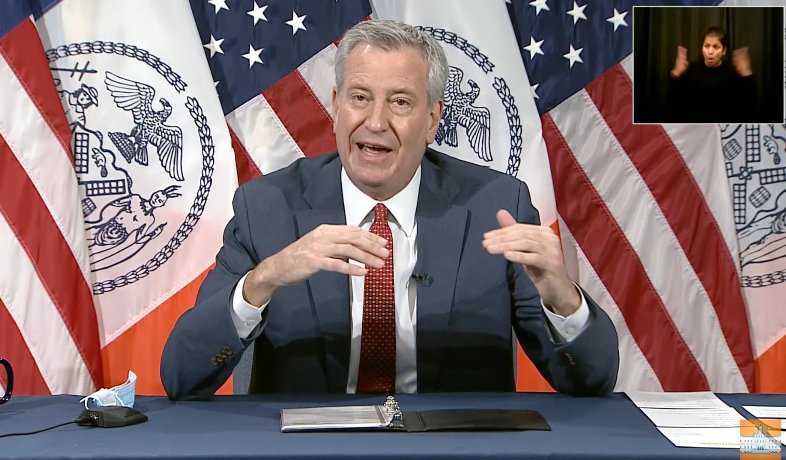NYC Will Begin Phased Reopening Of Public Schools On December 7th
Nov. 29, 2020, 12:03 p.m.
NYC public schools will begin to reopen in phases starting on Monday December 7th, Mayor Bill de Blasio announced on Sunday.

NYC public schools will begin to reopen in phases starting on Monday December 7th, Mayor Bill de Blasio announced on Sunday. The reopening will start with students in lower grades—3-K, Pre-K and elementary school—returning to in-person instruction on that Monday, with special education District 75 schools reopening on Thursday, December 10th.
De Blasio explained that the phased reopening is focusing on lower grades "because we know studies consistently show younger kids are having less of a negative experience and there is less concern about the spread when it comes to younger kids."
He added the demands on parents impacted the reopening strategy, acknowledging "how important it is to have their younger kids in school, both educationally and socially, but also how parents juggle all the challenges with their life."
A timeline for reopening middle and high schools has not been revealed.
"We will work to get to that day, but we're not there yet," de Blasio said.
Under the phased reopening, which mirrors what other elected officials had called for this summer, the city will also increase COVID-19 testing requirements from monthly to weekly. About 20% of the students at a given school would be tested under the plan, the mayor said.
"It will be done every week that school is in session," de Blasio said.
Consent forms allowing students to be tested for COVID-19 will be mandatory for attending in-person school, unless a student receives a medical exemption. (The form can be filled out online here.)
Any school that has enough space will also move toward in-person instruction five days a week for all students who have opted into the blended learning model. Before schools were shut down earlier this month, students participating in the hybrid learning model attended classes in-person just one to three days per week.
About 330,000 students could soon return to in-person instruction five days a week, including about 190,000 in the lower grades and at special education schools the week of December 7th. The mayor did not detail how students would be tested, but insisted insisted there would be enough supplies and locations for the testing mandate.
"Part of what we found because we’ve been expanding testing capacity constantly in New York City [is] that we now had a lot more we could utilize in schools," the mayor said.
De Blasio also said the DOE will work with the state to reopen as many schools as possible in the city's orange zones, which currently include parts of Staten Island. Schools are required to close when their location becomes part of the state's COVID-19 orange zone, but are able to "test out" of the closure with regular coronavirus tests of the staff and student body, including virus testing prior to returning to school grounds.
The mayor closed schools on Thursday, November 19th after the city passed a 3% positive coronavirus testing threshold that had been agreed upon with the teacher's union as part of the original school reopening plan. That 3% testing rate will no longer be the benchmark for closing schools. The city will continue to rely on the education department's "situation room" to assess potential classroom or school closures when positive cases arise.
"I know parents really were concerned and are very frustrated and I felt bad about it for sure," the mayor added. "But I felt we had to keep the commitment we made and we had to come up with something new."
On Sunday, de Blasio said the city's current positive testing rate was 3.9% on a seven-day rolling average, according to the city Health Department.
The teachers union was supportive of the phased approach.
"While schools in the city’s high-impact red and orange coronavirus zones will continue to abide by the state’s 3 percent closing rules, we are supportive of a phased reopening of schools in other neighborhoods as long as stringent testing is in place," said Michael Mulgrew, president of the United Federation of Teachers.
Mark Cannizzaro, the president of the Council of School Supervisors and Administrators, looked ahead towards school leaders' needs as the blended approach is phased out.
"School leaders deeply understand the need for children to learn in person as regularly as possible, so long as all safety protocols are based on the guidance of medical professionals," Cannizzaro said. "Now that the Mayor has indicated a desire to phase out blended learning, the DOE must provide clear direction and adequate resources in schools where it is possible and afford school leaders flexibility and discretion where it is not."
City Councilmember Mark Treyger, who chairs the City Council's education committee, said the model seems to draw from his proposal issued back in July, but leaves out key groups of vulnerable students.
"What I'm hearing today is a move in the direction of this elementary school model, but it's not truly equitable," Treyger said. "This proposal does not include all of our children with [individualized education programs]. It does not include all of our children in temporary housing. It does not include all of our English language learners. It does not include children in foster care. And quite frankly, I am not seeing any big announcement on trying to improve the remote learning experience, which is still the predominant learning platform for most of our children."
"[W]e still have a long way to go in terms of reaching equity," Treyger added.
With reporting from Gothamist's Sophia Chang and WNYC's Jessica Gould.
This article has been updated with additional information from union leaders and City Councilmember Mark Treyger.